What Are The Names Of The Blocks Used In The Garden Maze Antique Quilt 1820-1840?
The Mayflower Story
The Mayflower set sail on 16th September 1620 from Plymouth, UK, to voyage to America. But its history and story start long before that.
Its passengers were in search of a new life – some seeking religious freedom, others a fresh start in a different land. They would go on to be known as the Pilgrims and influence the future of the United States of America in ways they could never have imagined.
This story isn't just about the Mayflower's passengers though. It's about the people who already lived in America and the enormous effect the arrival of these colonists would have on Native Americans and the land they had called home for centuries.
More than 30 million people can trace their ancestry to the 102 passengers and approximately 30 crew aboard the Mayflower when it landed in Plymouth Bay, Massachusetts, in the harsh winter of 1620.
On board were men, women and children from different walks of life across England and the city of Leiden in Holland.
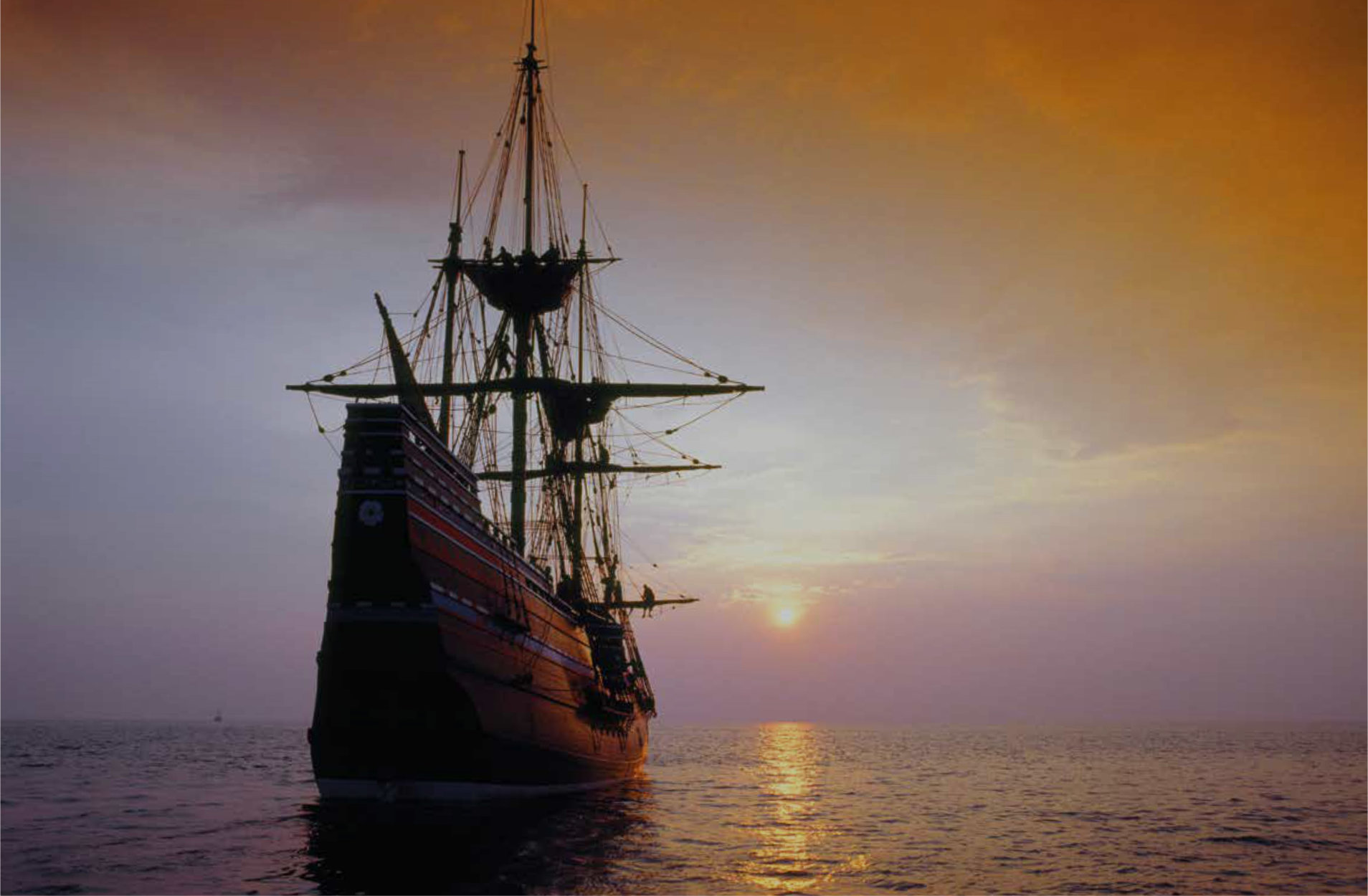
A significant number were known as Separatists, a group of people who mostly wanted to live a life free from the current Church of England.
Others were on the ship for a multitude of reasons – some anticipated the chance to build a better future for their families and the opportunity of new land, while for others the offer of freedom and adventure was too good to turn down.
Then there were the crew themselves, plus the servants and unaccompanied children sent by their families to be looked after by the adults.
The passengers are often grouped into 'Saints' or 'Strangers' by historians, alluding to their motivations for the journey. But it's likely that many 'Saints' were skilled tradesmen and many 'Strangers' had their own religious reasons for leaving 17th century England.
The origins of these passengers can be traced across England and in the Netherlands – as illustrated by the interactive map below.
Importantly, the Pilgrims were not the first to land in America, nor did they discover it. There were already established colonies at the time, not least Jamestown – founded in 1607.
But the Mayflower story is renowned for its themes of freedom and humanity – including the relationships first formed between the Native American Wampanoag tribe and the colonists and the first Thanksgiving.
We begin much earlier than 1620, in the villages, towns and cities of England.
The King of England
The decision by Henry VIII to break away from the Roman Catholic Church – principally so he could divorce his first wife, Catherine of Aragon, had far-reaching ramifications.
He created his own church, with its own rules determined by him - called the Church of England. In doing this, Henry was expelled by the Pope and the reformation of the English churches had started.
Many believed that Henry's new church was still too similar to the Pope's and wanted even more changes. Some wanted to separate it from other churches by purifying it of all Catholic practices. They became known as the Puritans.
However, others believed that you could not change the church and that the only way to form a new group was to break away entirely. They became known as the Separatists.
The Church dictated all aspects of life – from what you ate to what you wore. To dispute that rule was a dangerous path ending in prosecution. This was especially foreboding for Separatists.
The Separatist leaders
The leading religious Separatists who voyaged to America in 1620 mostly originated from an area where modern-day Nottinghamshire, Yorkshire and Lincolnshire meet.
Regarded as dangerous renegades who rejected fundamental principles of the State and the established Church of England, they worshipped in secret to avoid arrest and persecution.
Among them was William Brewster, who was brought up in the village of Scrooby in north Nottinghamshire.
Inspired by the radical words of Richard Clifton, the rector of nearby All Saints' Church in Babworth, Brewster is believed to have founded a Separatist Church in his family home - the manor house at Scrooby.
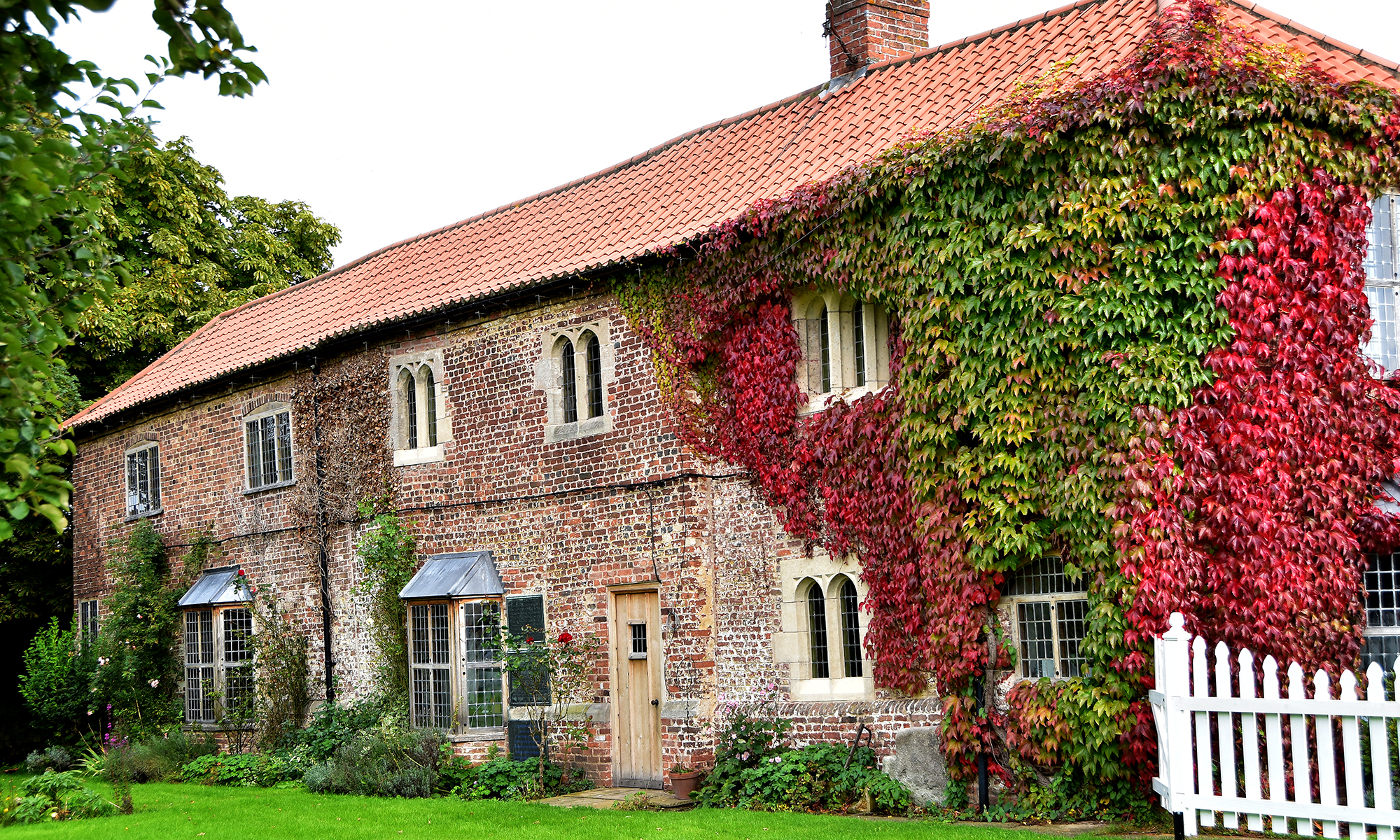
Scrooby Manor House
He was fined for non-attendance at St Wilfrid's Church in Scrooby but was respected as an elder and spiritual guide and played a significant role in the congregation's later journeys.
Brewster strongly influenced William Bradford from Austerfield, a nearby South Yorkshire village. When the Separatists landed in America, Bradford went on to become a Governor of the Plymouth Colony, serving for more than 30 years.
William Bradford's journal, Of Plimoth Plantation, records much of what happened to the group, including how they had become so persecuted that they could no longer live peacefully.
Bradford was baptised St Helena's church where the original font can be seen today. Heavily influenced by leading Pilgrim William Brewster, he was a sickly young orphan when they first met, but grew into a passionate religious radical.
A similar group had long been growing in the nearby town of Gainsborough in Lincolnshire, drawing members from surrounding villages. They would also worship clandestinely under the guidance of John Smyth at the Gainsborough Old Hall.
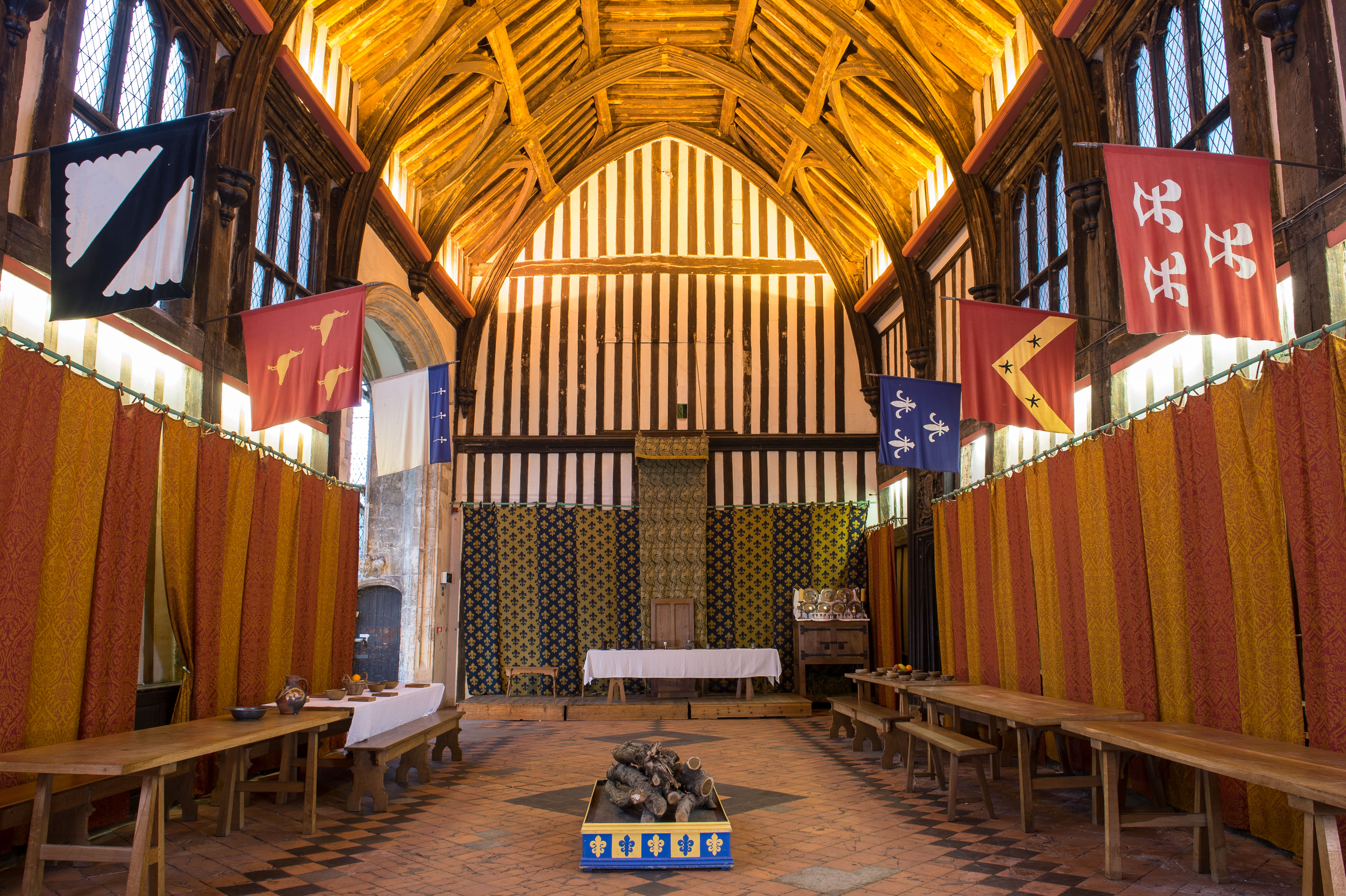
Inside Gainsborough Old Hall
Escaping to Holland
As the authorities intensified their crackdown on the Separatists, the two groups decided to flee England for Holland – seen as a liberal nation where they could live peacefully.
One night in the autumn of 1607, they secretly met a boat on the edge of 'The Wash' at Scotia Creek, near Boston in Lincolnshire – some having walked 60 miles.
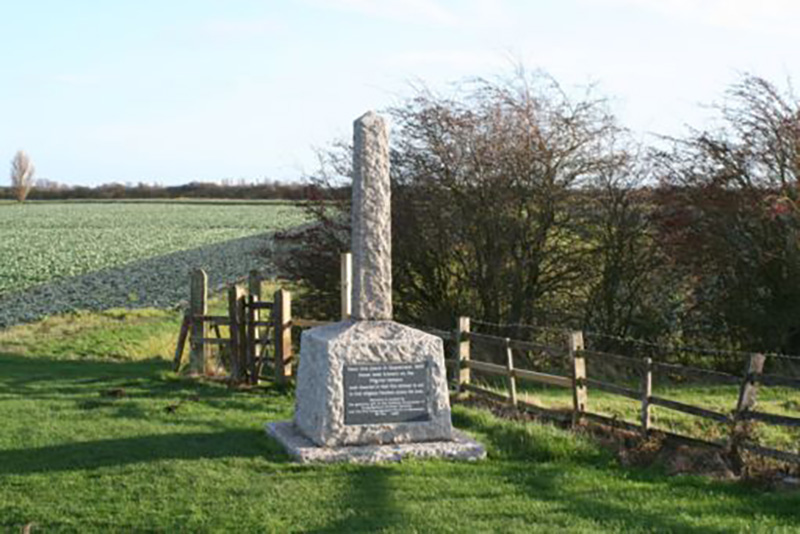
The monument at Scotia Creek that marks where the Pilgrims tried to make their escape
But the captain of a ship betrayed them and the local militia seized the group and took their money, books and personal possessions. Stripped of their belongings and hope, the group were brought by boat back to Boston and held and tried at the Guildhall, home to the local law court and cells.
They were eventually freed and made a second, successful attempt at fleeing to Holland – this time from the coastal town of Immingham in Lincolnshire.
A new life in Leiden
They settled in the city of Leiden via Amsterdam. Leiden was a city of free-thinkers, relative religious tolerance, and a long tradition of offering shelter to the dispossessed.
They built a life in Leiden, living and working here for 12 years. They built land near the spectacular Pieterskerk church and built houses in what is today known as the Engelse poort (English Alley).
Many worked in the textile industry and similar trades – but it was hard work and a challenging life. William Brewster operated a printing press in what is today known as 'William Brewster Alley'. Here he produced dissident pamphlets that were smuggled into England for distribution.
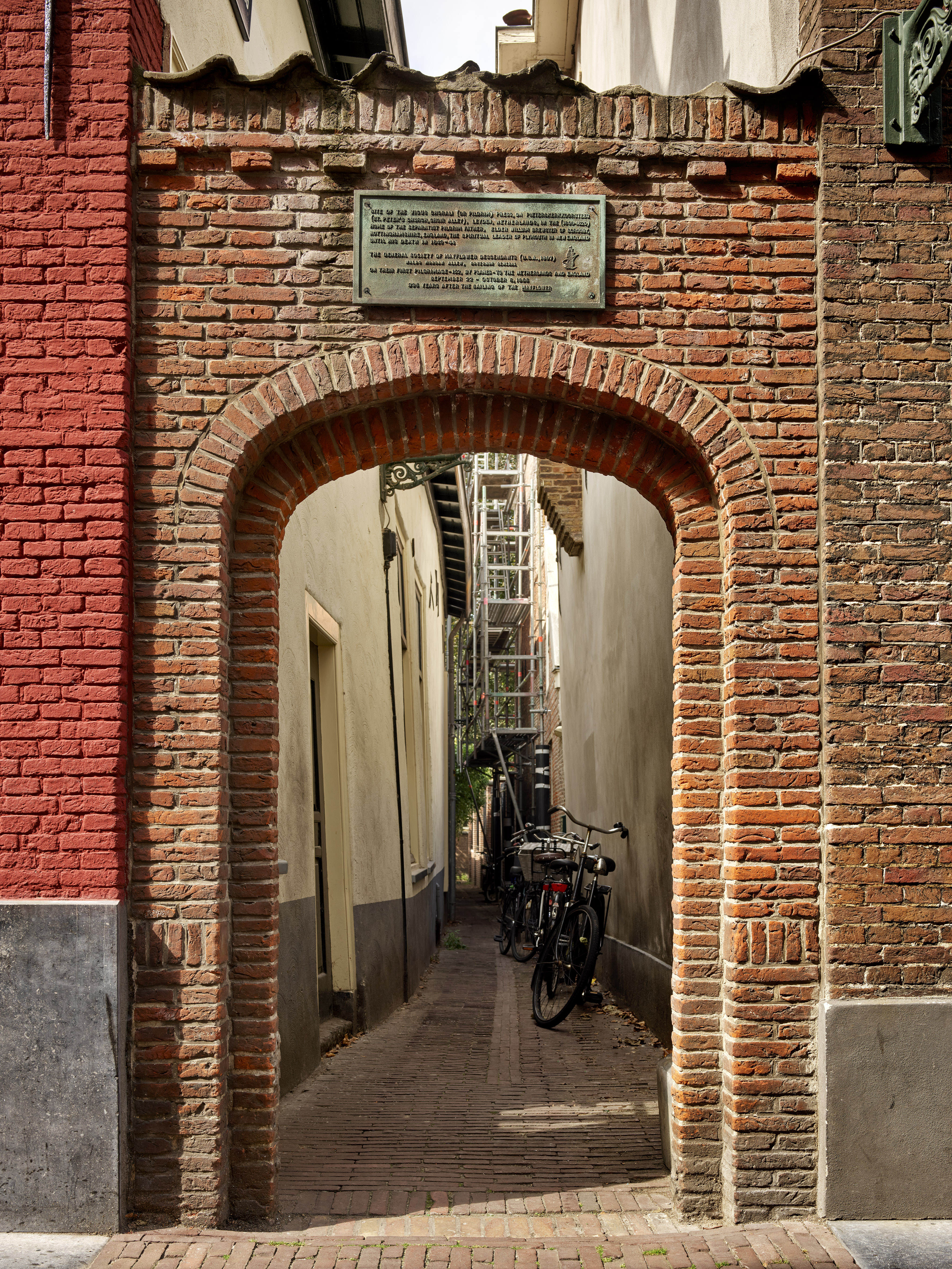
William Brewster Alley
Eventually the time in a foreign land took its toll and the group started to plan a journey to a new land to start again.
It's thought there were several reasons for this – not least that the fear their children were effectively growing up as Dutch children.
They wanted to find a place completely free of limitations where they could build a better economic future. They had been living in small houses with big families – and were becoming poor.
The looming threat of war with Spain also cast a cloud over their future.
From 1617 they planned to leave and eventually settled on Virginia in America.
More than half of the group stayed though and fully integrated into Dutch life. Among them was John Robinson, known as the 'pastor to the Pilgrims'.
Leiden had a profound influence on the lives of the Pilgrims - even after their departure. The concept of civil marriage was one innovation they took with them.
Planning the voyage to America
Virginia in America was an attractive destination because several colonies had already settled there. However, they also felt that they should not settle too near and end up with a similar environment to which they originally fled.
The Separatists worked with their counterparts in England to fund and organise the journey – which had to make commercial sense.
They negotiated with merchants in London and convinced them that funding their journey would see a return on investment thanks to the goods they would be able to send back to England. They also needed permission to land in Virginia and establish a colony.
A ship called the Speedwell would carry the Leiden group to America while another ship called the Mayflower was hired to take passengers who weren't necessarily travelling for religious reasons.
The Mayflower would sail from the port of Rotherhithe in London, carrying many there for work in the new land, who simply wanted to build a new life, crew and servants. Rotherhithe was home to many of the crew including the Mayflower's Captain Christopher Jones.
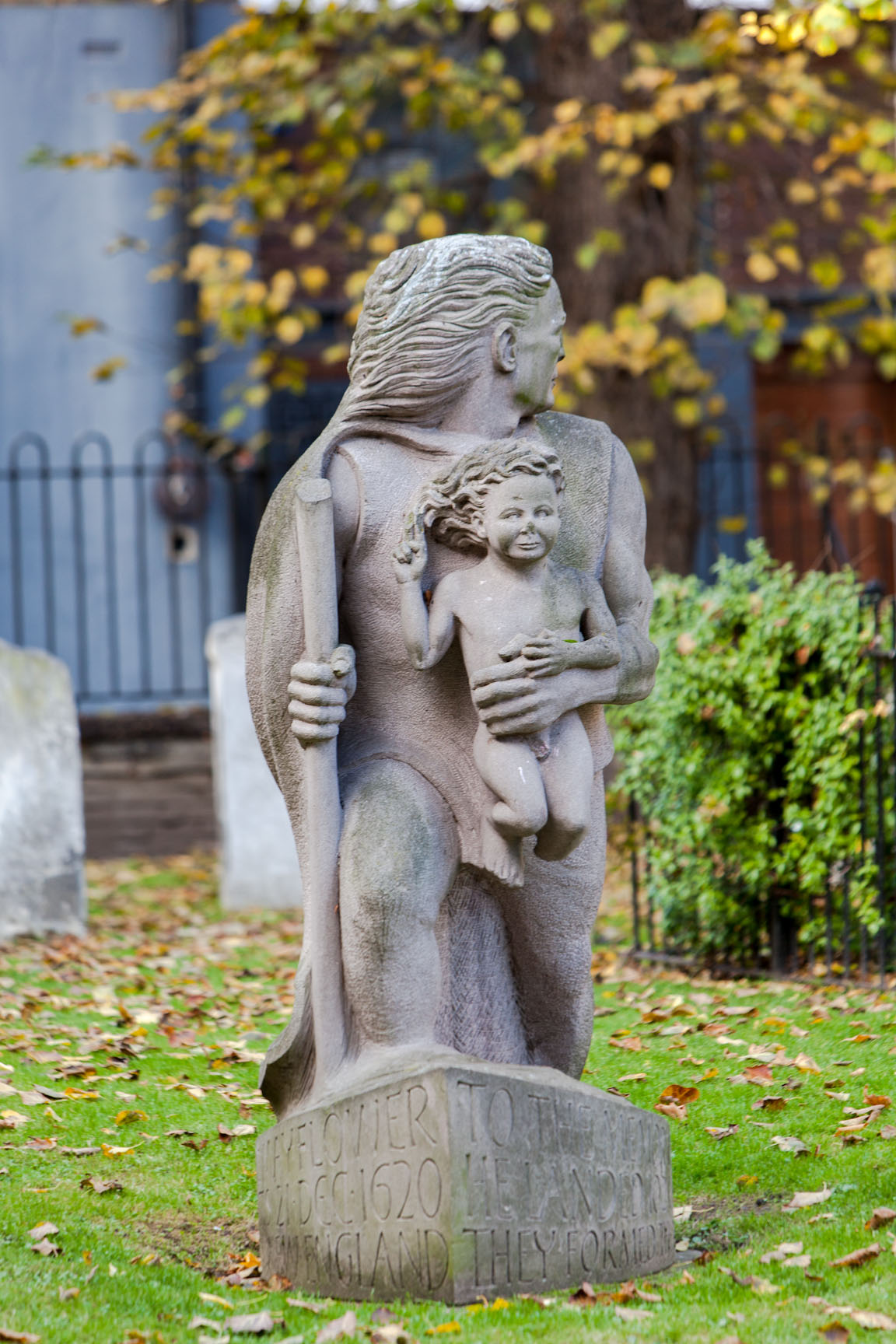
A statue of Christopher Jones found in St Mary's Church in Rotherhithe
Leaving England
The Speedwell set sail from Holland on 22nd July 1620, after a moving ceremony by the water's edge.
The plan was to meet the Mayflower in Southampton before heading off together across the Atlantic.
Southampton was a thriving seaport offering all the commercial facilities to provision and equip for the long sea voyage. Many of the buildings and streets familiar to the passengers then still exist.
When the two ships met in the port there were concerns about the Speedwell though, which needed repairs after developing a leak. But on 15th August 1620 the two ships weighed anchor and set sail from Southampton.
The two ships didn't get very far when the Speedwell began to take on water again. It may have been because she carried too much sail, straining her timbers, or the direct result of sabotage by a reluctant crew.
They changed course for Dartmouth, a port on the south coast of Devon. It took about a week for the port's skilled craftsmen to make good the damage.
Unfortunately, the second attempt did not go as hoped either. The Mayflower and the Speedwell were 300 miles clear of Land's End when the smaller ship yet again began leaking badly and could not risk continuing. The two boats turned about for Plymouth.
One last stop
By this time, the cramped, damp and miserable passengers had already spent up to six weeks at sea. With a fair wind and good fortune, they would have hoped to be nearing America by then.
The Speedwell was finally declared unfit for the journey. Some of the Pilgrims dropped out. The remainder crowded onto the Mayflower, which required re-provisioning, despite funds running low.
They left Plymouth on 16th September 1620, with up to 30 crew and 102 passengers on board. Just under half of them were Separatists, or Saints. They used the name Saints as a way to indicate that they were part of a particular group with a certain set of beliefs.
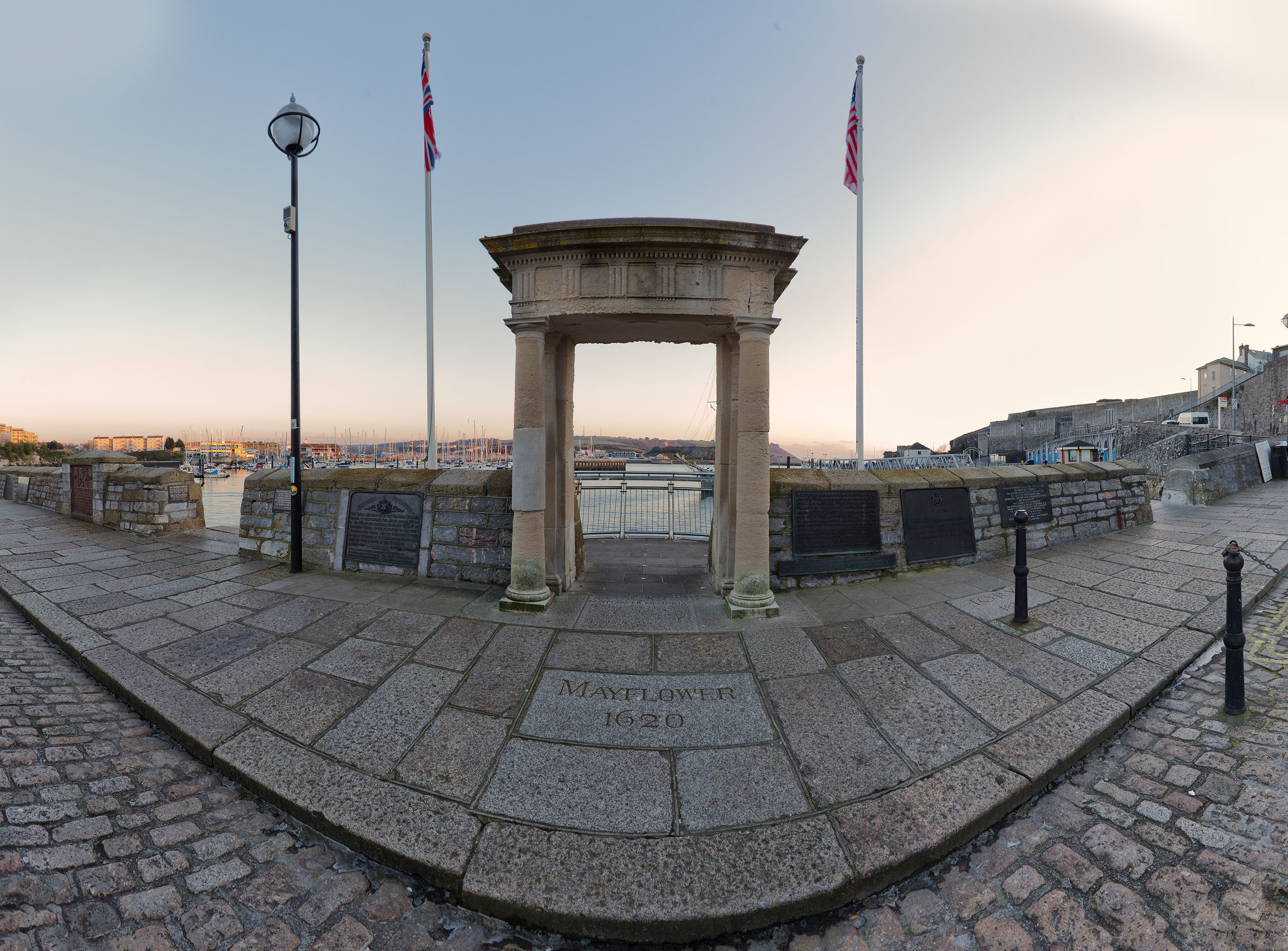
The Mayflower Steps in Plymouth, built as a memorial to the historic voyage
The rest were known as Strangers, as this is how the Saints viewed all others outside of their group. Many were skilled tradespeople sent by the investors to help build the new colony. Though plenty of the passengers could have probably been defined on either side of this divide.
The passengers
The following passengers were on board the Mayflower:
- John Alden
- Isaac and Mary (Norris) Allerton, and children Bartholomew, Remember, and Mary
- John Allerton
- John and Eleanor Billington, and sons John and Francis.
- William and Dorothy (May) Bradford
- William and Mary Brewster, and children Love and Wrestling
- Richard Britteridge
- Peter Browne
- William Butten
- Robert Carter
- John and Katherine (White) Carver
- James and Mrs. Chilton, and daughter Mary
- Richard Clarke
- Francis Cooke and son John
- Humility Cooper
- John Crackstone and son John
- Edward Doty
- Francis and Sarah Eaton, and son Samuel
- Thomas English
- Moses Fletcher
- Edward and Mrs. Fuller, and son Samuel
- Samuel Fuller
- Richard Gardiner
- John Goodman
- William Holbeck
- John Hooke
- Stephen and Elizabeth (Fisher) Hopkins and children Constance, Giles and Damaris; son Oceanus was born during the voyage.
- John Howland
- John Langmore
- William Latham
- Edward Leister
- Edmund Margesson
- Christopher and Mary (Prower) Martin
- Desire Minter
- Ellen, Jasper, Richard, and Mary More
- William and Alice Mullins and children Priscilla and Joseph
- Degory Priest
- Solomon Prower
- John and Alice Rigsdale
- Thomas Rogers and son Joseph
- Henry Samson
- George Soule
- Myles and Rose Standish
- Elias Story
- Edward Thompson
- Edward and Agnes (Cooper) Tilley
- John and Joan (Hurst) Tilley and daughter Elizabeth
- Thomas and Mrs. Tinker, and a son
- William Trevore
- John Turner, and two sons
- Richard Warren
- William and Susanna (Jackson) White, and son Resolved(son Peregrine was born shipboard in Provincetown Harbor after arrival).
- Roger Wilder
- Thomas Williams
- Edward and Elizabeth (Barker) Winslow
- Gilbert Winslow
- "Mr. Ely"
- Dorothy (John Carver's maidservant)
Source: New England Historic Genealogical Society
Sailing the Atlantic
The Mayflower took 66 days to cross the Atlantic – a horrible crossing afflicted by winter storms and long bouts of seasickness – so bad that most could barely stand up during the voyage.
By October, they began encountering a number of Atlantic storms that made the voyage treacherous. It was so bad that the sails often could not be used, instead they simply drifted.
One Stranger was swept overboard and one woman, Elizabeth Hopkins, gave birth to a baby boy, aptly named Oceanus.
The Pilgrims intended to land in Northern Virginia and the Hudson River (today New York) was their intended destination. They had received good reports on this region while in the Netherlands. The Mayflower was almost right on target, missing the Hudson River by just a few degrees.
As they approached land, the crew spotted Cape Cod just as the sun rose on November 9, 1620.
The Pilgrims decided to head south, to the mouth of the Hudson River in New York, where they intended to make their plantation.
But the rough seas nearly shipwrecked the Mayflower and instead they decided to stay and explore Cape Cod rather than risk another journey south. They anchored in what is now Provincetown Harbor. Shortly after, Susannah White gave birth to a son aboard the Mayflower, the first English child born in the colony. He was named Peregrine, derived from the Latin for 'pilgrim'.
The Mayflower Compact
The colonists knew they had no right to settle in this land they had unintentionally arrived upon and decided to draw up a document that gave them some attempt at legal standing.
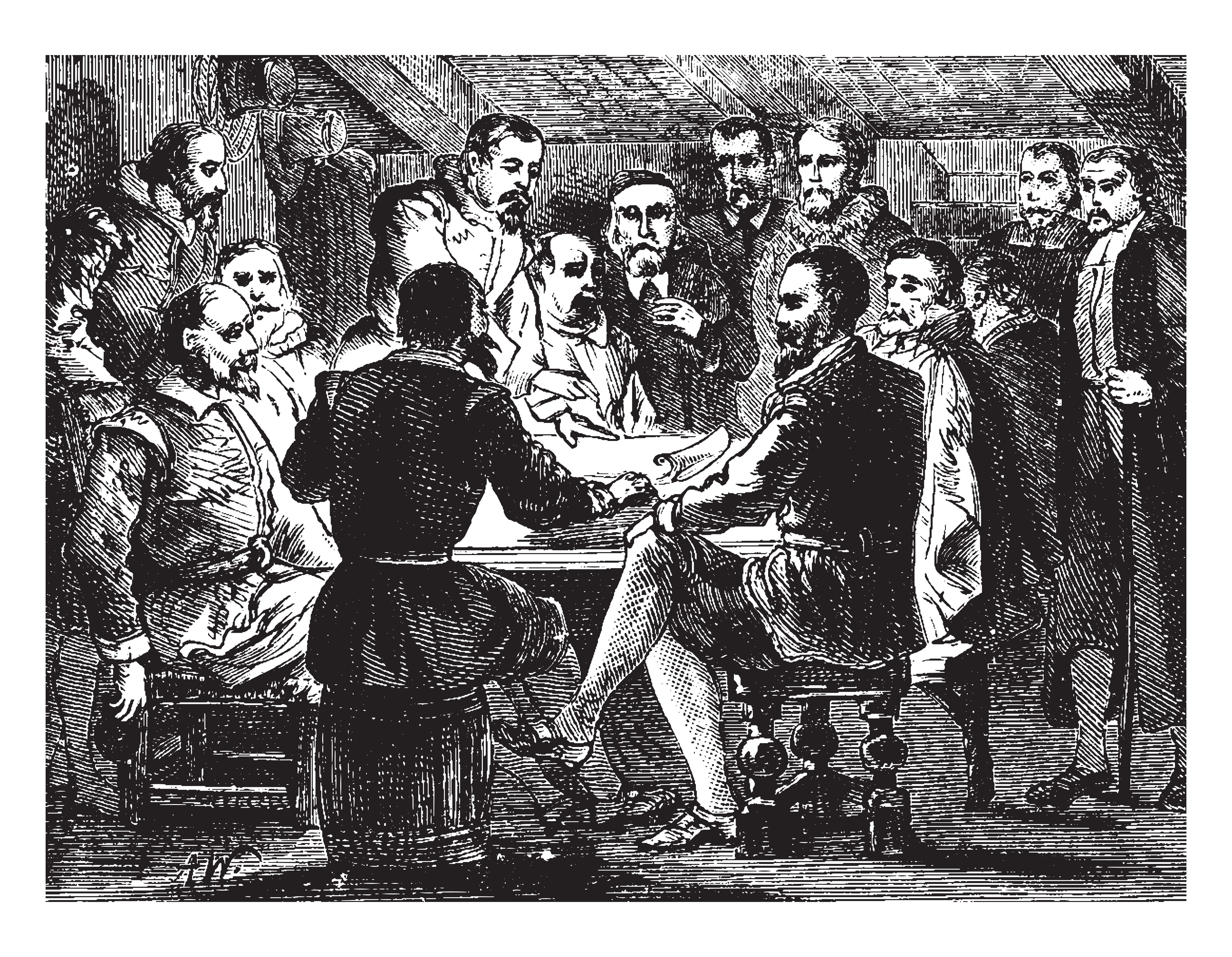
An illustration of the signing of the Mayflower Compact
So upon arrival the settlers drew up the Mayflower Compact. Signed by 41 men on board, the compact was an agreement to cooperate for the general good of the colony. They would deal with issues by voting, establish constitutional law and rule by the majority.
The document read:
In the name of God, Amen. We, whose names are underwritten, the loyal subjects of our dread Sovereigne Lord, King James, by the grace of God, of Great Britaine, France and Ireland king, defender of the faith, etc. having undertaken, for the glory of God, and advancement of the Christian faith, and honour of our king and country, a voyage to plant the first colony in the Northerne parts of Virginia, doe by these presents solemnly and mutually in the presence of God and one of another, covenant and combine ourselves together into a civill body politick, for our better ordering and preservation, and furtherance of the ends aforesaid; and by virtue hereof to enacte, constitute, and frame such just and equall laws, ordinances, acts, constitutions and offices, from time to time, as shall be thought most meete and convenient for the generall good of the Colonie unto which we promise all due submission and obedience. In witness whereof we have hereunder subscribed our names at Cape-Codd the 11. of November, in the year of the raigne of our sovereigne lord, King James, of England, France and Ireland, the eighteenth, and of Scotland the fiftie-fourth. Anno Dom. 1620.
Watching from the west
The Pilgrims would spend the next month and a half exploring Cape Cod, while most stayed on board the ship, trying to decide where they would build their plantation.
They searched much of the coastline in this region including the area now known as Plymouth.
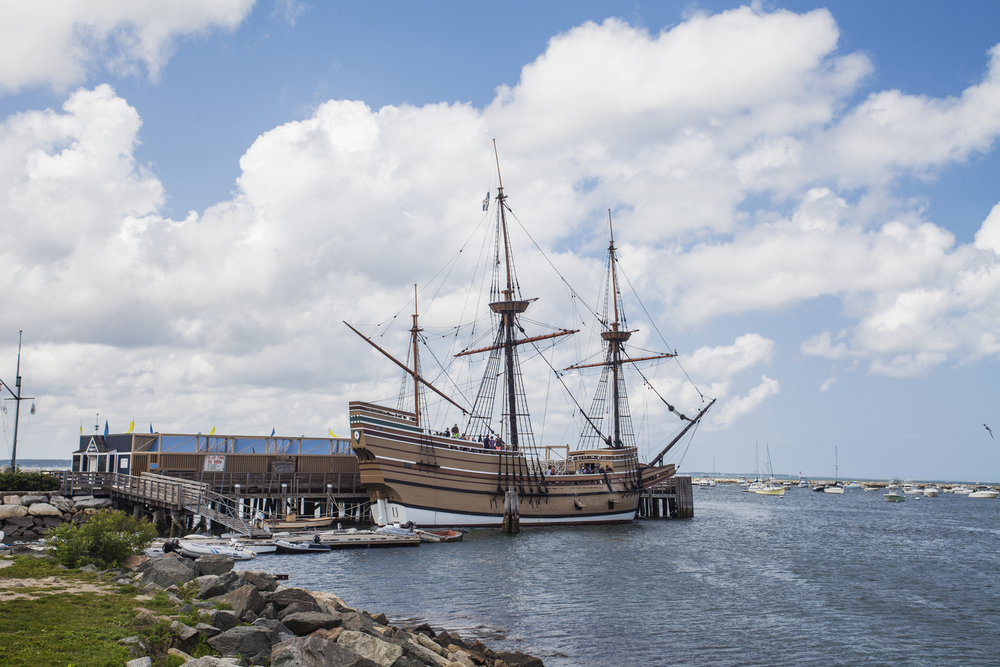
The replica Mayflower in Plymouth, Massachusetts today
Watching on were a small group of Native Americans, people for whom this area was already home. The new arrivals tried to follow them but got lost and stuck among some dense thickets. They decided to change course and came across cleared land where corn had been grown and abandoned houses.
They found buried corn, which they took back to the ship, intending to plant it and grow more corn, eventually returning what they had taken. They also found graves.
This village they had stumbled upon was once called Patuxet but had since been deserted following the outbreak of disease.
This was a legacy of what the Native American people had already experienced from European colonists in the 17th century.
The native inhabitants of the region around Plymouth Colony were the various groups of the Wampanoag people and other tribes, who had lived there for some 10,000 years before the Europeans arrived.
The Great Dying
When the Separatists were living in Leiden in 1616, in the same year a map was published detailing explorations of the Cape Cod area to the Bay of Fundy.
But these names were meaningless to the people who lived in this region, which is thought to have been known as Dawnland.
And to them 1616 was memorable for very different reasons – the outbreak of European diseases that would devastate their communities.
Ships from England had been fishing and trading in North America waters since the beginning of the 16th century. They would also bring Native Americans back to Europe – some as slaves – often to callously exhibit.
Some were taught English so they could become interpreters in future. In 1614, six years before the Pilgrims arrived, 27 natives were seized by a man called Thomas Hunt.
The majority came from Patuxet, the very abandoned village the Pilgrims would later find, and what is now modern-day Plymouth, Massachusetts.
One of these was named Tisquantum (also known as Squanto). Hunt tried to sell the natives as slaves in Spain but somehow Tisquantum made his way to England, where he learned some English and was used as an interpreter in future trips to America.
Eventually he found his way back to Patuxet, where tragically he found his family and village had been wiped out by disease brought by European settlers and explorers.
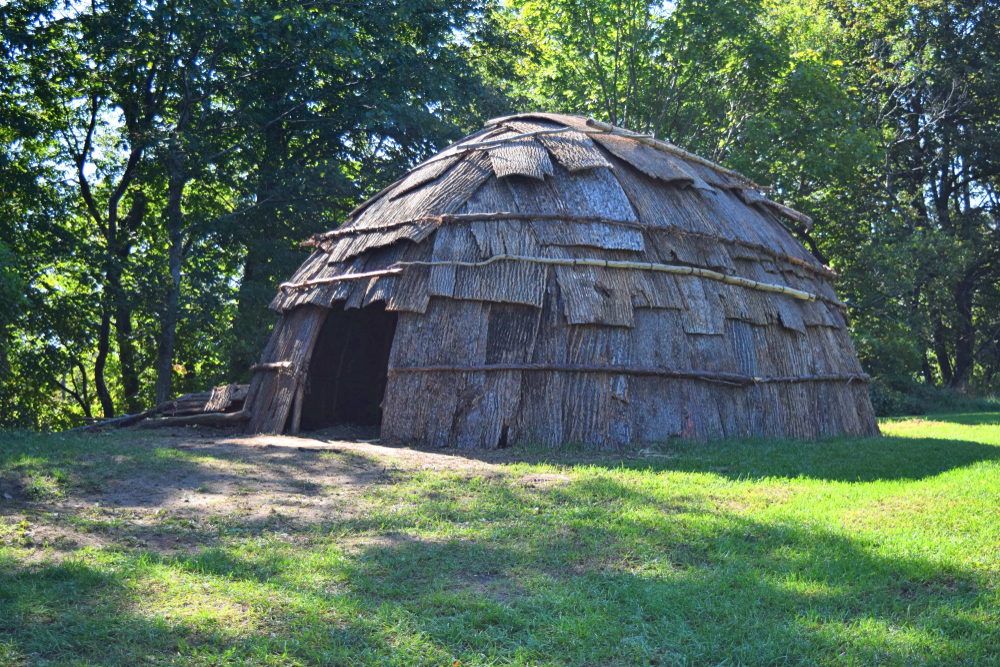
A Wampanoag hut
Between 1616 and 1619 a mysterious disease that would become known as the 'Great Dying' ravaged this region, before the Mayflower laid anchor in Cape Cod.
In the winter of 1616-17 an expedition dispatched by Sir Ferdinando Gorges found a region devastated by war and disease, the remaining people so "sore afflicted with the plague, for that the country was in a manner left void of inhabitants."
Two years later another Englishman found "ancient plantations" now completely empty with few inhabitants – and those that had survived were suffering.
So before the Mayflower arrived, this region had greatly suffered from the effects of colonisation.
The first harsh winter
Before settling on what is now Plymouth, the Pilgrims explored other areas of the coast, including an area inhabited by the Nauset people. They saw some figures on the shore who fled when they approached. They explored and found more graves, which they decided not to dig.
They remained ashore overnight and the following morning, they were attacked with arrows. The colonists shot back with guns but could not find them. That would be the last contact until the spring.
On December 25, 1620, the Saints and the Strangers departed the bleak shores of Provincetown and arrived, finally, in what is now Plymouth Bay, Massachusetts, on 26th December 1620.
They decided this place, once home to the people of Patuxet, would be where they settled and began construction of their first buildings.
But the first winter was cold and many of the passengers stayed on board the Mayflower. The ship became home to the sick and dying, with many succumbing to a mixture of contagious diseases.
Building the colony
The settlement's first fort and watchtower was built on what is now known as Burial Hill (the area contains the graves of Bradford and other original settlers).
The first common house nearly completed in January, built for general use. Each single man was ordered to join himself to one of the 19 families in order to eliminate the need to build any more houses than absolutely necessary.
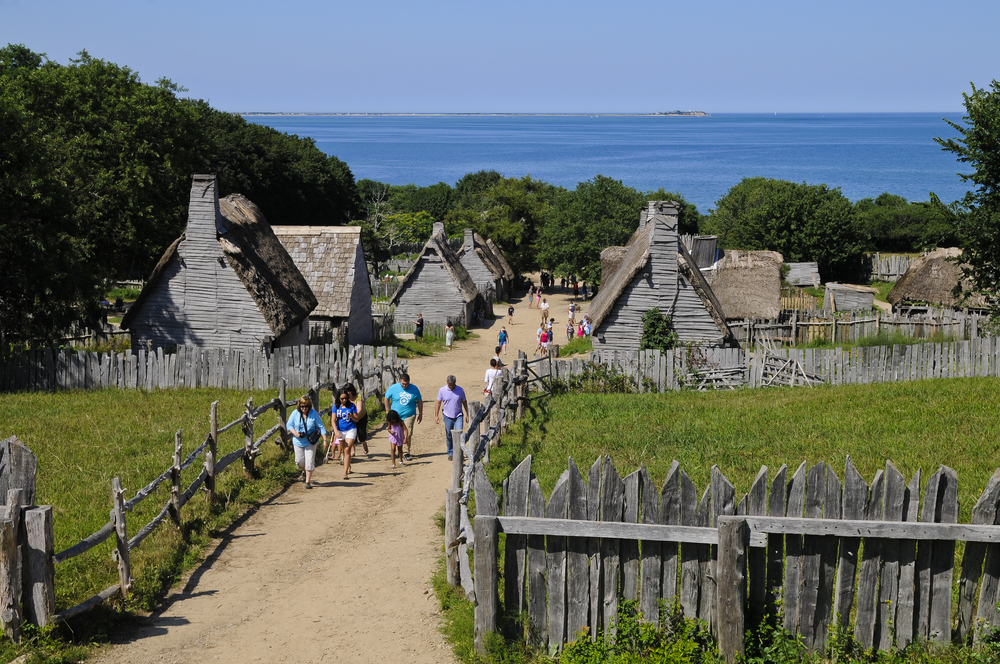
The Plimoth Plantation recreation of the village
Each extended family was assigned a plot and they each built their own home and the settlement was mostly built by February.
The first house was built as a hospital. Thirty-one of the company were dead by the end of February, with deaths still rising. Coles Hill became the first cemetery, on a prominence above the beach
Only 47 colonists had survived and at its worst just six or seven were able to feed and care for the rest. In this time, half theMayflower crew also died.
When his crew began to recover from disease, the Mayflower's captain Christopher Jones sailed the ship back to England, taking half the time that it did on its outward journey.
The Wampanoag and the Pilgrims
The Pilgrims were settling on land home to the Wampanoag – one of many tribes in the wider region. The Wampanoag had lived here for 10,000 years before they arrived.
Each tribe in New England had their own territory in which to fish, harvest and hunt. The boundaries for hunting were very strict as some areas had large populations.
The Wampanoag people knew how to work with the land and moved between sites to get the best of their harvest. They spent the summer near the shore and the winter in land, amongst the woods.
The Wampanoag worked together - a number of groups united together. A head Sachem managed a Sachem from each of the groups. Within this organisation, family and group links were the most important, connecting them to each other and their territory.
In the years before the Mayflower landed, The Wampanoag had been attacked by neighbouring tribes, losing land along the coast. Then came the Great Dying and the losses were so devastating that the Wampanoag had to reorganise its structure and Sachems had to join together and build new unions.
A historic peace
During March 1621, an English speaking member of the Wamponaog, named Samoset, entered the grounds of the Plymouth colony and introduced himself. He is said to have asked for a beer and spent the night talking with the settlers. Samoset, later, brought another member of his tribe – Tisquantum, whose experience meant his English was much advanced.
Tisquantum taught them to plant corn, which became an important crop, as well as where to fish and hunt beaver.
He introduced them to the Wampanoag chief Ousamequin, chief of the Pokanoket people known as Massasoit, an important moment in developing relations.
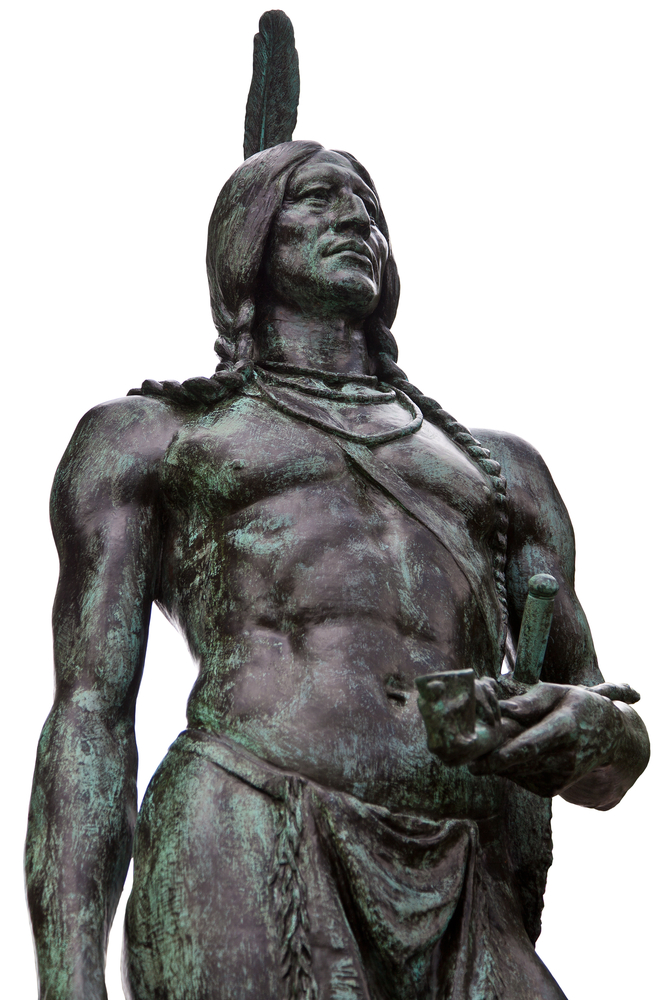
The statue of Ousamequin that stands on land he would have once ruled over today
One of the first to greet him was Edward Winslow, originally from Worcestershire. A leader in the Separatist group and a skilful diplomat, Winslow had not only been instrumental in organising the journey to America, but was also one of the men who signed the historic Mayflower Compact.
The Wampanoag were wary of the nearby Narragansett tribe, who had not been affected by the disease epidemics and remained a powerful tribe.
They demanded that the Wampanoag show them honour and tribute. Ousamequin would have known an alliance with these new English colonists might help fend off any attacks from the Narragansett.
In 1621, the Narragansett sent the Plymouth colony a threat of arrows wrapped up in snake skin. William Bradford, who was governor of the colony at the time, filled the snake skin with powder and bullets and sent it back.
The Narragansett knew what this message meant, and would not attack the colony.
Ousamequin and The Pilgrims established an historic peace treaty and the Wampanoag went on to teach them how to hunt, plant crops and how to get the best of their harvest, saving the Pilgrims from starvation.
It is believed that Winslow was even able to help nurse Ousamequin back to health when he fell ill, reportedly using his renowned chicken soup and strengthening their relationship further.
The first Thanksgiving
Success followed and following a bumper harvest in the autumn of 1621, the colonists decided to celebrate with a three-day festival of prayer.
The 53 surviving settlers invited their Native Americans friends to join them for a huge feast in what was to become known as the first Thanksgiving.
One of two first-hand accounts of this celebration was contained in the book Mourt's Relation, primarily written by Winslow. The book describes in detail what happened from the landing of the Mayflower Pilgrims right through to this celebratory feast.
Winslow's account states:
"Our corn did prove well, and God be praised, we had a good increase of Indian corn, and our barley indifferent good, but our peas not worth gathering, for we feared they were too late sown. They came up very well, and blossomed, but the sun parched them in the blossom. Our harvest being gotten in, our governor sent four men on fowling, that so we might after a special manner rejoice together, after we had gathered the fruits of our labors; they four in one day killed as much fowl, as with a little help beside, served the company almost a week, at which time amongst other recreations, we exercised our arms, many of the Indians coming amongst us, and amongst the rest their greatest king Massasoit, with some ninety men, whom for three days we entertained and feasted, and they went out and killed five deer, which they brought to the plantation and bestowed on our Governor, and upon the Captain and others. And although it be not always so plentiful, as it was at this time with us, yet by the goodness of God, we are so far from want, that we often wish you partakers of our plenty."
Today, the US celebrates Thanksgiving on the fourth Thursday of November.
The impact of colonisation
The repressive church rule in England would drive more people to follow the Mayflower to America. Another ship arrived in 1621 and two more in 1623.
In 1630, 1,000 Puritans arrived under Governor John Winthrop under a charter from by the Massachusetts Bay Company. Winthrop soon established Boston as the capital of Massachusetts Bay Colony, and it would soon grow into the biggest colony in the area.
These Puritans wanted to free themselves of the Church of England and 'purify' it from Roman Catholic practices.
They arrived under the guise of creating a perfect city – but ended up creating a society just as intolerant. Quakers were persecuted with public hangings and whippings.
Tensions between these colonists and the Native American people rose. The colonists brought more disease to which the Native Americans would have no immunity. Smallpox would ravage communities still recovering from the Great Dying. Violence increased.
By the 1630s, the Native Americans in this region were in the minority in their own lands and wars such as the brutal Pequot War reduced the population significantly.
By 1676 Boston was an economically flourishing town with a population of about 4,000 and had established itself as the dominant force.
King Philip's War
The carefully managed peace that had originated between the Wampanoag and the Plymouth colony was eventually shattered by King Philip's War in 1675.
When Ousamequin died in 1662 his son and heir Metacom no longer believed in the value of the alliance with the colonists. The collapse of trade agreements and the aggressive expansion of the colonies left relations at breaking point.
Tensions were raised when the colonists demanded the peace agreement should mean the Wampanoag hand over any guns, and hung three of the tribe for murder in 1675.
Metacom - who was known as King Philip by the English - led an uprising ofWampanoag, Nipmuck, Pocumtuck and Narragansett tribes. They came up against the biggest army the colonial leaders could muster, that fought in coalition with other tribes.
The war is seen as a final attempt to drive out the colonists and lasted 14 months. It is considered the deadliest war in American history.
The colonist army burned villages as they went and by the end of the war, the Wampanoag and their Narragansett allies were almost completely destroyed. Metacom fled to Mount Hope where he was finally killed by the militia.
This war was fought by colonists without support from England or any other European government and is often seen as the moment a new American identity was formed.
The fate of the Plymouth colony
Eventually the likes of Brewster and Winslow went on to found their own communities and the colony began to struggle. The cost of the war did not help and after a colonial governor was appointed to rule over New England in 1692, Plymouth was absorbed into Massachusetts.
The term Pilgrim originated in 1820, when during the 200th commemoration of the colony's landing they were referred to as the Pilgrim Fathers in reference to Bradford's manuscript where he names passengers on the boat from Leiden 'saints' and 'pilgrimes'. The phrase was coined.
Modern Response
The Native American activist group, The United American Indians of New England, continues to raise awareness of racism towards Native Americans and the consequences of colonialism. When the Wampanoag leader, Frank James, was informed that his speech was inappropriate and inflammatory for the annual Thanksgiving ceremony 1970, he refused to read their revised speech.
Supporters followed James to hear him give his original speech on Cole's Hill, next to the statue of Ousamequin. This became the first National Day of Mourning, which continues today in Plymouth, Massachusetts, on the same day as Thanksgiving.
What Are The Names Of The Blocks Used In The Garden Maze Antique Quilt 1820-1840?
Source: https://www.mayflower400uk.org/education/the-mayflower-story/
Posted by: boozeyoring40.blogspot.com

0 Response to "What Are The Names Of The Blocks Used In The Garden Maze Antique Quilt 1820-1840?"
Post a Comment